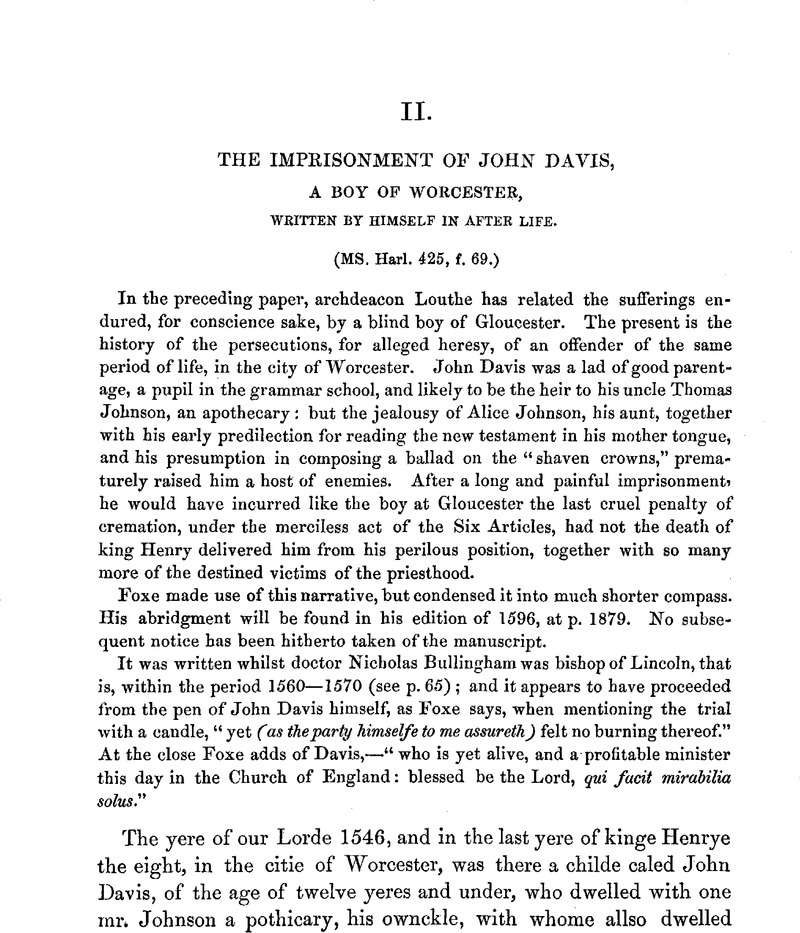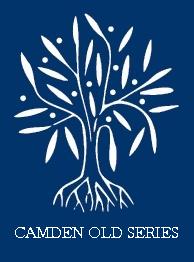No CrossRef data available.
Article contents
II. The Imprisonment of John Davis, a Boy of Worcester, Written by Himself in after Life
Published online by Cambridge University Press: 23 February 2010
Abstract

- Type
- Narratives of the Days of the Reformation
- Information
- Copyright
- Copyright © Royal Historical Society 1859
References
page 61 note a Robert Johnson.
page 61 note b This book or pamphlet has not been traced, but it seems to have been a parody or reply to doctor William Turner's Hunting of the Romish Fox, published in 1543, under the pseudonym of William Wraughton: the popularity of which appears not only from Turner's subsequent publications of The Resaiyng of the Romish Fox, 1545; The huntyng of the Romyshe Wolfe (after 1553); and The hunting of the Fox and Wolfe, because they did make havoc of the sheep of Jesus Christ (see Atheæ Oxon. edit. Bliss, i. 363, and the memoir of Turner in Hodgson's Northumberland, II. ii. 456); but also from bishop Bale's Yet a course of the Romish Foxe, 1543, published under the name of Johan Harrison (see Herbert's Ames, iii. 1554).
page 62 note a Eyebright does not appear to be noticed in doctor William Turner's Herball. In that by John Gerarde, chapter 216 treats “OF EYE-BRIGHT. Euphrasia, or Eyebright, is a small low herbe not above two handfuls high, full of branches, covered with little blackish leaves, dented or snipt about the edges like a saw: the flowers are small and white, sprinkled and powderd on the inner side, with yellow and purple specks mixed therewith. The root is small and hairie. This plant grows in dry medows, in green and grassie wayes and pastures standing against the snnne. Eye-bright beginnith to floure in August and continueth unto September, and must be gathered while it flowreth forphysick's use. …. It is very much commended for the eyes. Being taken it selfe alone, or any way else, it preserves the sight, and being feeble and lost it restores the same.” Then several prescriptions are given, concluding thus: “Three parts of the powder of eye-bright and one part of maces mixed therewith, taketh away all hurts from the eyes, comforteth the memorie, and cleareth the sight, if halfe a spoonfull be taken every morning fasting with a cup of white wine.” (Gerarde's Herball, 1633, p. 663.) Drayton describes the gathering of eyebright:
“And in some open place, that to the sun doth lye,
He fumitorie gets, and eyebright for the eye.”—Polyolbion, Song 13.
And Milton alludes to it under its more learned name—
—— “Then purg'd with euphrasy and rue The visual nerve, for he had much to see.1'—Paradise Lost, xi, 415.
page 64 note a A syncopised phrase signifying that a person more than suspected what he did not positively know.
page 64 note b “So called from its having for many ages been the only accessible approach to the cemetery of the cathedral, by which the dead were brought thither for interment.”—Green's History of Worcester, 1796, 4to. ii. 4.
page 65 note a This was evidently the town-hall or head-quarters of the municipal government, apparently deriving its name from being the office for collecting toll. The more ordinary term for such places in olden times was toll-booth, and sometimes, the tolsey.
page 65 note b William Dodington and Richard Dabitote, bailiffs in 1545, according to the list given in Nash's History of Worcestershire, vol. ii. Appx. p. cxii. But the name of the former was doubtless Dodding, as it is given ibid, under 1543, when he was lower bailiff: and there was a Thomas Dodding bailiff in 1558, 1562, and 1564. The other, whose name was probably Dabitote (after the ancient Worcestershire family of d'Abitot), was senior bailiff in 1547. A Humphrey Debitote occurs bailiff in 1518 and 1521.
page 65 note c Richard Bullingham was lower bailiff of Worcester in 1561, and upper bailiff in 1563. A Thomas Bullingham had filled those offices in 1528 and 1530.
page 65 note d Nicholas Bullingham was born in Worcester; educated at Oxford; was consecrated bishop of Lincoln 1559, and translated to the see of his native city in 1570. He died in 1576, and was buried in the cathedral, where his monument remains, with a demi-effigy, as described in Green's History of Worcester, i. 154, and engraved in Dr. Thomas's Survey, 1737, 4to. p. 41. See a memoir of bishop Nicholas Bullingham in Wood's Athens Oxon. edit. Bliss, ii. 813. There was also a John Bullingham, bishop of Gloucester 1581 1596, and previously prebendary of Worcester, whose memoir is ibid. col. 862.
page 65 note e This test was not unusual. One of Poxe's cuts represents Bilney burning off the forefinger of his right hand, on the day before his submission to the fire at Norwich. Another exhibits bishop Bonner burning with a candle the hand of Thomas Tomkins, whose body soon after was burned in Smithfield. In a third, Edmund Tyrrell, of Colchester, is burning in like manner the hand of one Rose Allin; and in the same place bishop Bonner is stated to have forcibly closed the hand of a third person upon a live coal.
page 66 note a Richard Gtowle in Nash's list (Hist, of Wore. Appx. p. cxii), but no doubt in error, for under the name of Robert Youle he occurs as higher bailiff two years later, for 1548; and again in 1552 and 1559.
page 65 note b It must not be supposed that this was a watchman, or a particularly wakeful gentleman, who took nightly walks instead of lying in bed; but the writer means the occupation which is commonly written walker, that is, a fuller, or dresser and finisher of cloth. Worcester was at this period a great clothing town. Leland says, “The wealth of the towne of Worcester standeth most part by drapering, and no towne in England, at this present tyme, maketh so many clothes yearly as this towne doth.” (Itin.) In 1590 queen Elizabeth, “at the humble petition of our wellbeloved of the misteryes or faculties of weavers, walkers, and clothiers of our cittie of Worcester,” granted them a charter of incorporation, of which Rowland Berkeley, citizen’ and weaver, was nominated the first master, and two weavers and two walkers the first wardens: see it printed in Green's History of the city, vol. ii. Appendix, No. xvi.
page 67 note a “R. C. a writer in Camden's Remaines (sir Robert Cotton) says that we use waluthowe in hallooing as an interjection. (Rem. p. 33.) I have been curious to find an example of it, but have not succeeded.” Archdeacon Nares, in Glossary, 1842, 4to. The above appears to be the same “interjection,” differently written.
page 67 note b Henry Joliffe, B.D., appointed prebendary of the fourth stall by the foundation charter of the cathedral 24 Jan. 1541–2. He was one of the proctors of the university of Cambridge in 1536, rector of Bishampton, co. Wore, and in 1554 dean of Bristol.
page 67 note c Richard Euer, B.D., appointed to the third stall by the same charter.
page 67 note g So the MS., perhaps for by.
page 68 note a This was in the Foregate, at Worcester : his former prison at the toll-shop or guildhall.
page 68 note b Sir William Portman, a judge of the King's bench 1547, afterwards chief justice.
page 68 note c Sir Edward Mervyn, a judge of the King's bench 1541.
page 68 note d Afterwards sir John Bourne, secretary of state : who will figure more conspicuously in Underhill's Autobiography hereafter. He resided at Battenhall near Worcester.


